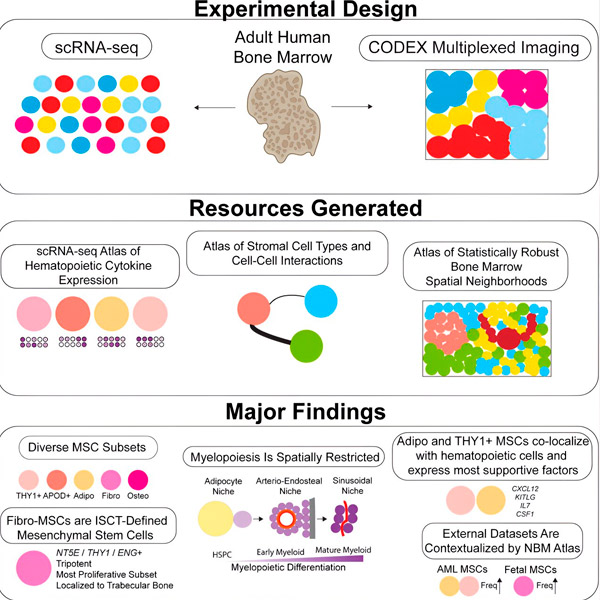Nye publikasjoner
Et biomolekylært atlas av benmargen gir et unikt innblikk i hematopoieseprosessen
Sist anmeldt: 02.07.2025

Alt iLive-innhold blir gjennomgått med medisin eller faktisk kontrollert for å sikre så mye faktuell nøyaktighet som mulig.
Vi har strenge retningslinjer for innkjøp og kun kobling til anerkjente medieområder, akademiske forskningsinstitusjoner og, når det er mulig, medisinsk peer-evaluerte studier. Merk at tallene i parenteser ([1], [2], etc.) er klikkbare koblinger til disse studiene.
Hvis du føler at noe av innholdet vårt er unøyaktig, utdatert eller ellers tvilsomt, velg det og trykk Ctrl + Enter.

Forskere ved Children's Hospital of Philadelphia (CHOP) og Perelman School of Medicine ved University of Pennsylvania har laget et kraftig nytt benmargsatlas som vil gi publikum et unikt visuelt pass til spekteret av frisk og syk hematopoiese. Resultatene er publisert i tidsskriftet Cell.
«For første gang vil vi ha et omfattende rammeverk for å se hele genuttrykket og den romlige organiseringen av benmargsceller », sa seniorforfatter Kai Tan, PhD, professor ved Institutt for pediatri og forsker ved Center for Childhood Cancer Research ved CHOP. «Selv om artikkelen vår er grunnleggende, ser vi for oss at atlaset vil bli brukt til å utvikle nye diagnostiske tester, identifisere nye mål for CAR-T-terapi og andre terapeutiske tilnærminger, og oppdage romlige biomarkører for sykdom.»
Selv om initiativet ble ledet av CHOP og Penn, er forskningen også en del av et større prosjekt kalt Human BioMolecular Atlas Program (HuBMAP). HuBMAP-konsortiet består av 42 forskjellige forskningsgrupper fra universiteter i 14 stater og fire land. Forskere samarbeider for å lage neste generasjon av molekylære analyseteknologier og beregningsverktøy som vil lage grunnleggende vevskart og atlaser over funksjonene og forholdet mellom celler i menneskekroppen.
«Forskning av denne størrelsen er bare mulig gjennom en monumental laginnsats», sa Showik Bandyopadhyay, PhD, hovedforfatter av studien og en lege-forsker under utdanning i Tans laboratorium. «Gjennom samarbeid på tvers av flere institusjoner og forskningskonsortier, var vi i stand til å få grunnleggende innsikt i menneskekroppens mikroskopiske byggesteiner.»
Forskere har lenge teoretisert at selv om mesteparten av benmargen består av blodceller, kan en liten prosentandel av ikke-blodceller spille en viktig rolle i benmargssykdommer hos barn og voksne, som leukemi, myeloproliferative lidelser eller benmargssviktsyndromer. Frem til denne studien hadde imidlertid slike studier blitt hindret av tekniske utfordringer knyttet til sjeldenheten og skjørheten til disse cellene.
Denne artikkelen er den første som overvinner disse begrensningene og omfattende profilerer voksen menneskelig beinmarg ved hjelp av enkeltcellet RNA-sekvensering. Denne teknikken muliggjør fangst av komplette genprofiler av titusenvis av individuelle celler, og avslører den fulle sammensetningen av celletypene som utgjør et organ.

Kilde: Cell (2024). DOI: 10.1016/j.cell.2024.04.013
I studien fokuserte forskerne på benmarg, som regulerer viktige prosesser i blodcelleutvikling og immunitet. De identifiserte minst ni undertyper av ikke-hematopoietiske celler, inkludert stromale celler, beinceller og endotelceller (blodceller), hvorav minst tre ikke hadde blitt beskrevet tidligere, som produserte viktige støttefaktorer. Forskerne laget et leksikon over disse sjeldne ikke-blodcellene som produserer faktorer som antas å være viktige for menneskelig hematopoiesis, noe som vil bidra til å bedre forstå hvilken cellulær kommunikasjon som bør fokuseres på i fremtidige studier.
Resultatene deres fremhever den stadig viktigere rollen teknologi spiller i dagens biomolekylære forskning. Forfatterne laget et romlig atlas av benmarg, inkludert rundt 800 000 celler, ved hjelp av en sofistikert ny teknikk kalt CODEX kombinert med maskinlæring. Denne tilnærmingen, sammen med nøye manuell annotering av tusenvis av celler og strukturer, tillot dem å fastslå at sunn benmarg har en veldig distinkt romlig organisering, og at fettceller er nærmere beslektet med hematopoietiske celler enn tidligere antatt.
«Vi har så vidt begynt å forstå hva som er mulig», sa Tan. «Fremtidige studier kan bygge videre på arbeidet vårt og akselerere forskningen på beinmarg, med håp om at disse digitale veiene en dag vil føre til medisinske gjennombrudd i behandlingen av akutt leukemi og andre beinmargssykdommer.»
Ling Qing, PhD, en annen seniorforfatter av studien og professor i ortopedisk kirurgi ved Perelman School of Medicine, er enig og mener at studien vil gi langsiktige resultater.
«Når disse teknikkene brukes på prøver fra leukemipasienter, avslører de en ekspansjon av mesenkymale celler, en type sjeldne ikke-blodceller, på stedet for kreftceller i benmargen», sa Qing. «Dette peker på en mulig ny retning for fremtidig sykdomsbehandling.»
